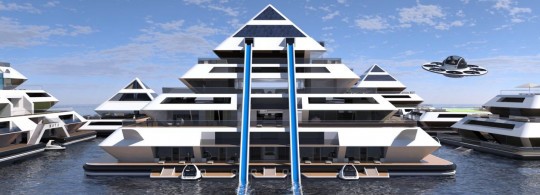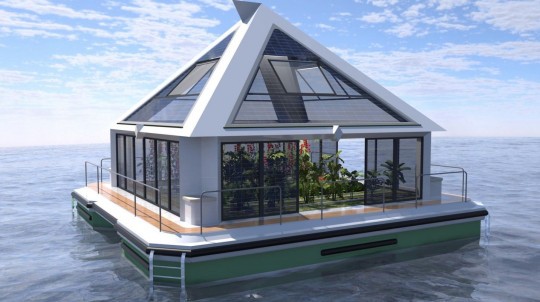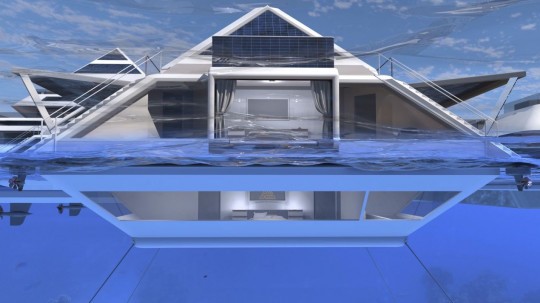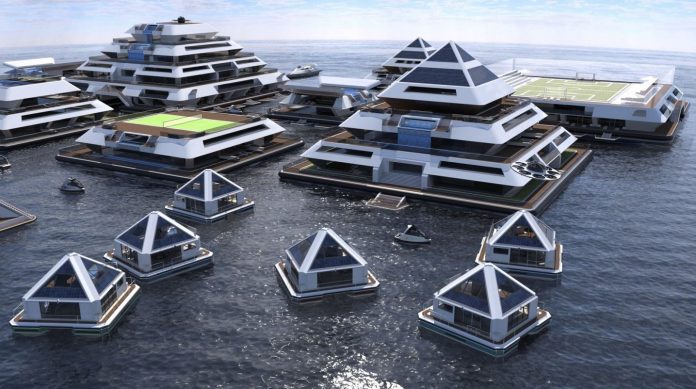Worried about rising sea levels and motivated by the desire to deliver a new, fully-sustainable residence of the future, many designers have embraced the idea of floating homes. Not one of them, though, has dared dream such a bold and beautiful dream as Pierpaolo Lazzarini of Lazzarini Design.
The Lazzarini Design studio was never a stranger to headline-grabbing projects, from cars, powerboats, flying cars, megayachts and, yes, even floating homes. Wayaland is a beautiful sum of all these, a floating community of solar-paneled pyramids that can move for short distances, are entirely self-sufficient, modular and multi-functional, and as luxurious as the pocket of the future owner is deep.
A Waya is neither yacht nor house, but takes the best of each and delivers a new living concept. It’s a modular floating building inspired by Mayan architecture and partly from a Japanese temple, Lazzarini Design explains. The studio imagines one small unit as the core of the Wayaland community, a “new offshore living experience, […] built around the human on the water.”
Wayaland is a floating city comprised of Wayas of various sizes and functionality. Depending on size, layout and features, Wayas can serve as hotels, residential units, gyms, greenhouses, cinemas, shops, sports venues (of smaller sizes) and, of course, floating beach clubs.

The smallest Waya would have 2 floors and a 10 by 10-meter (32 by 32-foot) platform. The biggest, the hotel, could rise up to 30 meters (94.4 feet) above the waterline, stretch over 10 floors and a total surface of 6,500 square meters (69,965 square feet), and include everything from a boat garage in its belly to roof-mounted pools and helipads.
Made of fiberglass, carbon fiber, and steel, all Wayas include a floating platform with an underwater room that can also serve a variety of purposes, from underwater bedrooms to extra storage space. All units, regardless of size, would be able to move around for short distances, presumably at very slow speeds, and would be moored the rest of the time using a 4-point anchoring system much like the U.F.O. concept we discussed on a previous occasion. The modules themselves could serve as mooring docks for powerboats or larger watercraft, or even as charging stations for these.
Speaking of charging, Lazzarini Design imagines all modules fitted with solar panels and other alternative energy sources like wind turbines and a system of batteries hidden in the floating platform. Also there would be weights that would keep the units stable.

“The energy, provided autonomously from solar panels and water turbines, contribute to power with clean energy all the services and systems of the pyramids, including desalinators which are located in the storage under the main level,” the design studio explains.
“In the submerged part of each floating structure, a large amount of storage space is used for the engines, equipments, generators or additional energy resources,” Lazzarini further says.
Functionality of the basic Waya could extend underwater, as noted above. A greenhouse Waya, for instance, could include a submerged room that would serve as bedroom or living quarters for whoever is tending to the floating garden.
In theory, Wayaland is a beautiful, bold dream for a not too distant future: life as a perpetual holiday with no impact on the environment, but a hefty one on the residents’ budget. In reality, the concept has been around since at least 2018 and has, so far, failed to garner any financial interest, for all the headlines it’s been making.

Lazzarini has taken to crowdfunding to make the Wayaland dream real: the studio is trying to raise €350,000 ($382,000) to build the smallest, basic unit to prove the entire project’s feasibility. In return for their contribution, pledgers are offered anything from a Wayaland passport to the chance to vote for the location of a future Wayaland community, and one-night stays for 2 people at the first hotel that will open. That last option is €1,000 ($1,091), so there’s that for your assumption that Wayaland was even remotely accessible to all citizens – of the future or present.
Should the project secure the desired amount, Lazzarini Design will open the first Waya in 2022.






